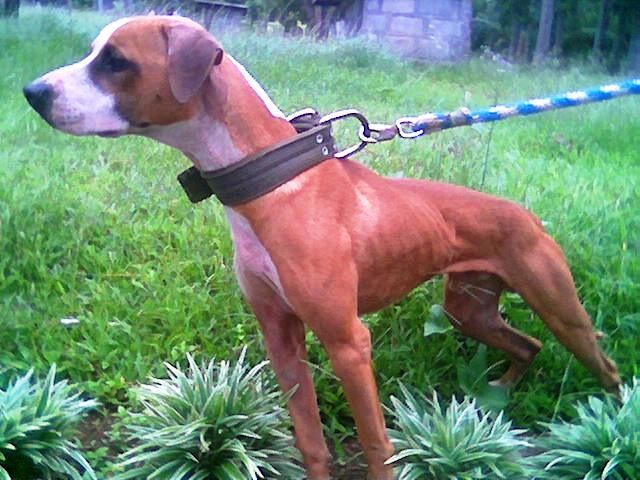-
Senior Member

What Say Ye?
This is a dog I bred several years ago and sent overseas. Admittedly, the dog is kind of a unique looking speciman. What can you say about this dog?
-
Senior Member

The color and ears tell me that he probably has some Andy Capp blood in him. He's tall and long so he has very good wind. Long snout makes it easy for him to get his opponent out of hold. He looks like a low 40 lber. And you know what they say about them weird looking pits...the ugly ones are usually the good ones. That's why I prefer them then a nice looking boxy pit. But by the look of that dog, he looks great naturally.
-
I like him....He looks to be equipped.Looks athletic.
-
Senior Member

He's bred like this:
http://www.apbt.online-pedigrees.com...&dog_id=230130
I bred these dogs up hastily so I could send the bitch over to them bred. She had 10 pups for them, including some good ones. The sire was all of 10-11 months old, the grandsire was open to show. Well, as luck would have it the grandsire quit around :45 after a respectable showing, and the sire also quit. Needless to say, this is a segment of our family that was completely abandoned by us. I have said it hundreds of times and I will say it again; too much of that Boyles based blood and they will come up short more often than not. The more I lean on my CH Costello traits, the more consistent and game the dogs are. This is a delicate balance trying to keep both talent and deep gameness. Fortunately, the Lulu bitch who is the dam of this guy pictured above ended up in good hands and lived to be 11 years old. They did some key breedings with her, and I think her legacy will continue for decades to come.
-
Senior Member

You know..I thought about doing something similar. I wanted to breed a winning bitch of mine to a young nephew of hers. The reason was because I wanted something off her before she would be show again. After some hard thinking, I decided to not do it and wait on that male to come of age. Well I started schooling that male and he never got turned on after 3 try. After his 3rd schooling, I culled him. And 2 weeks later I have no regret about what I did.
-
Senior Member

Al Brown said "sometimes I zigged when I should have zagged".
Hindsight is a wonderful thing. When I first bred the Whosonfirst dog I truly thought he was the best in the litter. From a performance standpoint he was, finishing a son of Homer III in :22 that left everyone shaking their head in disbelief. (Lesson here is they can look good at home once or twice, but a match is a whole different deal). It turns out his 2 brothers (Whatsonsecond 2XW & Batters) and sister Tiller were much better dogs. Roto was getting old, so I thought breeding her to her "best" son would be a great deal to preserve 87.5% of her genetics. I only got 2 pups, neither met our standards. She was a great producer crossed and inbred once. When you stacked it too tightly, I believe I was pulling traits from those dogs out of the 4th and 5th generation that were suspect on gameness. Their son Littleman was the wildest, most intense dog I had ever bred, and I'd have bet anything he was good. I worked him on cattle as a pup, and he was just super agressive with a very high prey drive. He had ability also, but he too was not game.
This dog pictured above has a double long neck. In general, this can be a real advantage on offense because he will have excellent shaking power, and defensively it is difficult for an opponent to get past the head to the body. Nevertheless, I have seen dogs with phenotypical handicaps overcome them, and plenty of perfect specimen who couldn't seem to make the body work for them. Therefore, a great pit dog is great much more because of his mind and heart, than his body.
-
Member

I like how he looks, and like the long neck as well it really can be a great advantage.
-
I wish I had logged on earlier to play in the guessing game. LOL. Based on your post you bred the dogs young. That is completely up to the owner. The recipes to success are so varied amongst bloodlines/families/breeders it is impossible to say this happened because you did this or didn't do that. As far as going forward the positive is that you know what you did did not pan out. It would have been much worse to continue to breed and reproduce this particular set of of dogs based on how they were bred vs. how they performed. When performance is the standard it is a lot easier to get back on track when things do not go as planned. You tried something, it did not work as thought, you made adjustments and continued on. That is as good as it gets in just about anything, even the dogs. EWO
 Posting Permissions
Posting Permissions
- You may not post new threads
- You may not post replies
- You may not post attachments
- You may not edit your posts
-
Forum Rules

